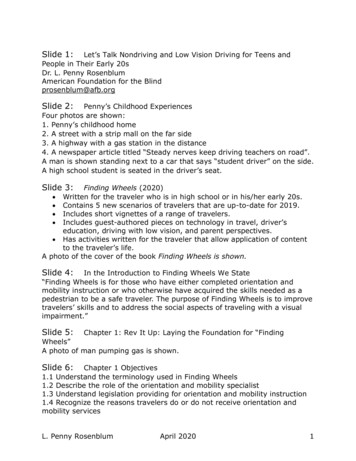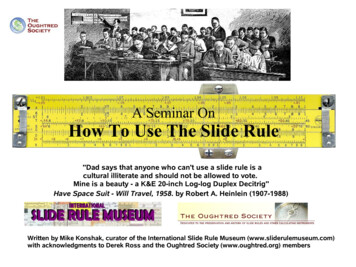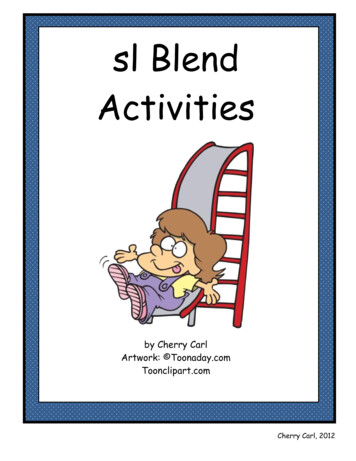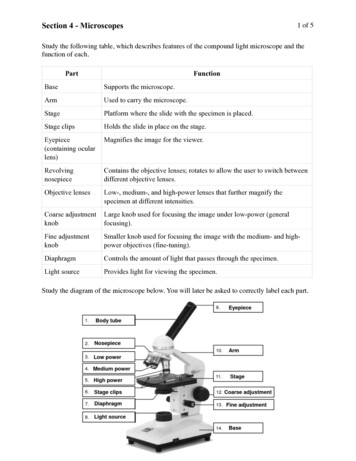
Transcription
Slide 1:Let’s Talk Nondriving and Low Vision Driving for Teens andPeople in Their Early 20sDr. L. Penny RosenblumAmerican Foundation for the Blindprosenblum@afb.orgSlide 2:Penny’s Childhood ExperiencesFour photos are shown:1. Penny’s childhood home2. A street with a strip mall on the far side3. A highway with a gas station in the distance4. A newspaper article titled “Steady nerves keep driving teachers on road”.A man is shown standing next to a car that says “student driver” on the side.A high school student is seated in the driver’s seat.Slide 3:Finding Wheels (2020) Written for the traveler who is in high school or in his/her early 20s. Contains 5 new scenarios of travelers that are up-to-date for 2019. Includes short vignettes of a range of travelers. Includes guest-authored pieces on technology in travel, driver’seducation, driving with low vision, and parent perspectives. Has activities written for the traveler that allow application of contentto the traveler’s life.A photo of the cover of the book Finding Wheels is shown.Slide 4:In the Introduction to Finding Wheels We State“Finding Wheels is for those who have either completed orientation andmobility instruction or who otherwise have acquired the skills needed as apedestrian to be a safe traveler. The purpose of Finding Wheels is to improvetravelers’ skills and to address the social aspects of traveling with a visualimpairment.”Slide 5:Chapter 1: Rev It Up: Laying the Foundation for “FindingWheels”A photo of man pumping gas is shown.Slide 6:Chapter 1 Objectives1.1 Understand the terminology used in Finding Wheels1.2 Describe the role of the orientation and mobility specialist1.3 Understand legislation providing for orientation and mobility instruction1.4 Recognize the reasons travelers do or do not receive orientation andmobility servicesL. Penny RosenblumApril 20201
1.5 Understand the relationship between effective travel skills and the areasof the expanded core curriculum1.6 Explain the differences between independent, interdependent, anddependent travel1.7 Describe how technology can support travelersSlide 7: Three Types of TravelersIndependent travelers: take control of their transportation needsincluding planning, budgeting, problem solving, and managing thesocial aspects of travelInterdependent travelers: at times everyone is interdependent,travelers need to strike a balance between independent andinterdependent travelDependent travelers: lack the skills and/or the motivation to beindependent or interdependent travelersSlide 8: Digital, Wearable Low Vision DevicesAllows the user with low vision to receive information at near or at adistance with greater detail.Aira, is a service that connects a traveler with a trained agent who isin a remote location and provides visual information. Users need anapp and “Smart Glasses” to use the service or if a business subscribesto Aira users can connect via the app. https://aira.io/Slide 9:Digital Wearable Low Vision Devices (cont.) Caution AboutWearable Technology OrCam, which is positioned on a pair of glasses enables the traveler topoint to a sign, and the information on the sign is read aloud throughan earpiece. https://www.orcam.com/en/ ESight is worn on the head and provides electronic magnification witha wide angle of vision. https://www.esighteyewear.com/#How-eSightWorks NuEyes is worn like a pair of glasses and functions as a videomagnifier for near or at a distance. This device can be voice activated.https://nueyes.com/nueyes-pro/Slide 10: Cautions About Wearable Technology Devices that cover the eyes of a traveler affect the traveler’s field ofview including restriction of peripheral vision.Discuss with travelers if devices should only be used when stationary.L. Penny RosenblumApril 20202
Slide 11: Chapter 2: Got Our Wheels: Meet Five TravelersBalance of travelers who are: Blind and those with low vision Congenital vs. adventitiously visually impaired Living in different types of communities Making different choices after high school Comfortable and less comfortable with travelSlide 12: Layla: Building My Travel Toolbox 22 years oldVisual acuity of 20/200Had TSVI services in K12Received O&M through a summer programWent to culinary school after high school graduationSlide 13: Javier: Hell No! I Won’t Go! 19 years oldRecent high school graduateLives in a rural communityAttended a 10-week residential program where he reluctantly workedwith an O&M specialistAsks neighbors for a ride to/from choir practiceSlide 14: Ana Maria: I’m Just Not Sure Came to the US at age 10 from GuatemalaHad a brain tumor at age 12 resulting in blindnessReceived O&M in high school, but the family did not want any offcampus travelLives with her boyfriend and works in a dentist’s officeIs very nervous about taking the busHer parents want her to move back home and go to collegeSlide 15: Kendra: Getting My License 23 years oldDiagnosed with Stargardt’s in 8th gradeGrew up in a rural community but opted to attend college in an urbancommunityLearned about low vision driving her freshman year of college andlearned to drive her junior yearChooses not to drive in snow or rainL. Penny RosenblumApril 20203
Slide 16: Harley: There’s an App for That! 20 years oldLives in a small city and attends community collegeLoves technologyWas very angry when he was 16 and could not get a driver’s licenseWalks and uses buses to travel and is pleased with his level ofindependenceSlide 17: Chapter 3: Tuning Up Your Wheels: Understanding One’s VisualImpairment and Its Implications for Nondriving and Low Vision DrivingPhoto shows a student pointing to a piece of paper as he looks at an eyemodel in the teacher’s hand. The teacher is pointing to the eye model.Slide 18: Chapter 3 Objectives3.1 Name and describe one’s visual impairment including the diagnosis,prognosis, and one’s functional use of vision3.2 Understand the type of information available in the reports prepared byprofessionals3.3 Describe one’s visual needs to others during travel and distinguish whatinformation to provide to different individuals3.4 Describe one’s feelings about being a nondriver3.5 Identify reasons why some people without visual impairments do notdriveSlide 19: Reflecting on Kendra’s ScenarioDo you remember when Kendra was excited when she learned she met thevisual requirements to drive in her state?Think About It: Why do you think it is important for travelers with lowvision to understand how they can use their vision during travel?The Challenges of Low VisionSlide 20: The Challenges of Low Vision Low contrast sensitivity: difficulty seeing differences between twosurfaces - locating curbs, seeing walk lines, recognizing the bottom ofa set of stairs and the start of the sidewalkPoor color vision: difficulty identifying objects with color cues identifying traffic light colors, recognizing blue from purple on the wallsof a subway stationLow acuity: difficulty seeing detail - reading a map, reading streetsigns, identifying small objects in a path, locating and readingaddressesL. Penny RosenblumApril 20204
Slide 21: The Challenges of Low Vision Light sensitivity: extreme sensitivity to normal light levels - difficultywith sunlight directed toward the traveler, glare from reflections off asurfaceCentral field restriction: missing details directly ahead at a distance,- needing to turn one’s head or eyes, missing an object directly infront of the travelerMid- and far peripheral field restrictions: missing objects to thesides, especially those that are in near space; missing curbs;difficulties in low light environmentsPoor night vision: having problems with dim light conditions such asdawn, night, or dusk – challenges entering a darkened place from asunlit areaSlide 22: Finding Wheels Activity: Understanding My Visual Impairmentand Sharing Information About it With OthersPurpose: To understand your own visual impairment by reviewing reportsthat [lists professionals] have prepared about you. Then, to develop a way toshare key information with others, as appropriate, so they understand yourvisual abilities and needs during travel.Steps to Do the Activity: Decide what reports to review and collect them. Read each report and Research terms and information you don’tunderstand. Develop a way to present the information so others understand yourvisual impairment and the way it affects you during travel. Make a list of questions you still have and how you will get theinformation.Slide 23: Grace Explains Her Visual ImpairmentvideoSlide 24: Finding Wheels Activity: My Feelings About Being a Traveler witha Visual ImpairmentPurpose: To more fully understand your feelings about being a traveler witha visual impairment, now and in the future.Steps to Do the Activity: Think about your travel experiences in the last week, last month, oreven the last year. Write down or record your answers to thesequestions or ones you come up with about traveling as a person with avisual impairment. Think about your future.L. Penny RosenblumApril 20205
Slide 25: Kate Shares Her FeelingsVideoSlide 26: Chapter 4: Facilitating Changing Directions: On the Road toIndependent WheelsPhoto shows a woman with a cane in one hand as she holds a toddler by theother hand. Together they are at the top of a set of stairs.Slide 27: Chapter 4 Objectives4.1 Understand how orientation and mobility instruction can support one’sdevelopment of travel skills.4.2 Describe the sequence of independent travel for those with typical vision4.3 Describe rites of passage for individuals in technologically orientedsocieties and how travelers participate in rites of passage4.4 Recognize what travel-related skills one needs to learn for one’s currentand future needs4.5 Discuss how access to transportation can influence current and futurelifestyle choices4.6 Describe how nondrivers and low vision drivers structure their lives withrespect to transportationSlide 28: Sample Snapshot: How O&M Instruction Can Support theDevelopment of Travel SkillsHolly vividly recalls the day that she got her driver’s license at age 16 andthe freedom it represented. Unfortunately, she also recalls the day 3 yearsago when at 19 she caused a car accident because she did not see the car infront of her come to an unexpected stop. It was dusk and with her nightblindness, she knew she shouldn’t be driving. She was only a kilometer fromher apartment and thought she could make it home before dark. Hollycarries a lot of guilt about hurting others in that accident. For a long timeshe didn’t want anything to do with rehabilitation services. She restricted herindependent travel to daytime using the local bus and her bike. Recentlythough her vision has continued to decrease, and the eye doctor says theprognosis is that she will one day be blind. At the urging of her girlfriend,Holly reluctantly agrees to go to the local rehabilitation agency and find outabout services. She knows it’s time to learn to use a cane, but the idea ofputting her visual impairment out there terrifies her.Question: What would you say to Holly to help her see the value of workingwith an orientation and mobility specialist and learning to use tools duringtravel?L. Penny RosenblumApril 20206
Slide 29: Driver’s Education – Dr. Molly PasleyReasons travelers may take driver’s education: Requirement to earn a high school diploma. Understand what drivers do so she can anticipate their behaviors whentraveling independently Wants to understand what makes someone a safe driver. Exploring low vision driving and needs to develop the understanding ofinformation covered in the classWhat are other reasons travelers should take driver’s education?Slide 30: Driver’s Education – Dr. Molly PasleyAdvantages of taking driver’s education: Learn about signage, street markings, and other content that canassist them in their own traveling Learn about safe and unsafe driving behaviors Increase their knowledge so they can decide if a driver is someonethey are safe having drive themSlide 31: Chapter 5: Personal Wheels: Walking, Biking, Rollerblading, andSkateboardingPhoto shows a teenage girl with a cane in her hand walking in a crosswalk.Slide 32: Chapter 5 Objectives5.1 Examine the characteristics of each method of personal travel5.2 Identify advantages and disadvantages of personal methods of travel5.3 Solicit information from the internet, maps, and individuals to plan andcarry out personal travel5.4 Identify considerations for using personal travel including (a) decidingwhere to live, (b) safety, (c) scheduling, and (d) costSlide 33: Bicycling with Low Vision Understand and follow the rules of the road.Learn to use hand signals to effectively communicate with drivers.Take a cycling class through parks and recreation or other groups tolearn bicycle safety and maintenance. Always wear a bicycle helmet. Use a mirror that allows you to monitor traffic behind you. Wear bright clothing that is reflective.Photo shows a woman on a bicycle riding on a street.L. Penny RosenblumApril 20207
Slide 34: Bicycling with Low Vision Pre-plan trips using a website or appDevelop monitoring skills to watch for vehicles coming out ofdriveways, vehicles running red lights, or changing traffic signals.Practice a new route at off hours.Plan routes that maximize safety.Slow down when a light is green and you are approaching anintersection so you arrive at the intersection when the light is turningyellow or red.Wave drivers on since you can’t make eye contact.Avoid bicycling at dawn or dusk when you are less visible.Slide 35: Safety: Personal Wheels Travel at times of day and on routes that are heavily traveledBe prepared for the weatherTake a self defense classHave a charger and/or backup battery for mobile devicesCarry a wide-angle flashlight or headlamp to provide extra lighting indim conditionsCarry extra money and a credit cardSlide 36: Travelers Exploring Dog Guide Ownership Developing an understanding of how a dog guide team works togetherUnderstanding the responsibility of dog guide ownershipRecognizing the need to continually educate the publicUnderstanding the application and training processMaintaining the training receivedPhoto shows a woman with a dog guide walking down a street in a businessdistrict.Slide 37: Being Specific When Asking for Directions Can you describe the color of your building to me?Is your business located at the street or is it set back from the street?If I’m facing Miller’s Hardware, would I walk to the left or the right toget to your store?I’m not familiar with 35th Street. Can you tell me where a lightedintersection is, so I can cross safely?I use a small telescope to help me locate things. Where on the buildingis the building number located?L. Penny RosenblumApril 20208
Slide 38: Finding Wheels Activity: Exploring a Future Community WhereYou Might LivePurpose: To consider a community in which you may live, the transportationoptions available in the community, and where specifically in the communityyou may live to maximize your transportation options.Steps to Do the Activity: Gather and review information about the community by using theinternet, making phone calls, or requesting information. Information togather includes services available in the community, location ofactivities, and crime rates. Make a list of your priorities for where you want to live in thecommunity. With a map of the community, locate places in the community whereyou might want to live.Slide 39: Penny’s Personal Consideration List Living on one of 4 bus routes that go to the university Being less than .4 miles from a bus stop Having access to road(s) with bike lanes Having easy access to a multi-use path for bicycling Being within a mile of a grocery store Being in a part of town where I’d “be on the way” for friends Being in a neighborhood w/o “cookie cutter houses”Photo shows a house with a little free library and mailbox on the street.Slide 40: Chapter 6: Public Wheels: Buses, Trains, Subways, Ferries,Airplanes, and ParatransitPhoto shows a teenager at an airport kiosk with an airport employee.Slide 41: Chapter 6 Objectives6.1 Identify the characteristics of public methods of travel including buses,trains, subways, ferries and airplanes6.2 Identify the characteristics of paratransit services and understand thequalification process to use these services6.3 Identify advantages and disadvantages of public methods of travelincluding buses, trains, subways, ferries and airplanes and the advantagesand disadvantages of paratransit services6.4 Solicit information from the internet, maps, and individuals to plan andcarry out travel using public transportation or paratransit6.5 Recognize the importance of strong orientation, mobility, andcommunication skills when traveling using public transportation and how useof these skills may differ for those using paratransit servicesL. Penny RosenblumApril 20209
6.6 Identify considerations for using public methods of travel including: (a)safety, (b) scheduling, and (c) costSlide 42: For Families and ProfessionalsFamily members and professionals supporting travelers who are exploringdifferent public forms of transportation may wish to arrange experiencesusing a variety of methods, including paratransit services when appropriate.Even if family members are drivers, planning trips as a family using differentforms of public transportation can be both fun and educational. Familymembers who are not familiar with public transportation options can enlistthe help of others who use these options regularly and can take their childon an outing using a method the child is not familiar with. When families orprofessionals are using public methods of travel with children, it is importantto give them responsibilities when planning for and during travel. A travelercan plan the route, call the company to get the time the bus leave a specificstop, pay the fare, and signal the driver when the family is at their stop.Slide 43: When There are No Public Wheels Visit to a city where students pre-plan a trip Set the stage for students to meet and interact with others Invite an adult role model Opportunities to develop other ECC skillsThere are three photos.1. Two adults and two teens are at a bus stop.2. A teen uses a monocular in a mall3. Two teenage girls have their arms around each other with big smiles ontheir faces.Slide 44: Amanda Shares the Value of the ExperienceVideoSlide 45: Finding Wheels Activity: Am I Candidate for Paratransit?Purpose: To find out the requirements for using paratransit in your currentor future community and to learn if you qualify for the service.Steps to do the Activity: Locate the paratransit company’s informationReview eligibility criteriaDetermine if you meet the eligibility criteriaComplete the applicationL. Penny RosenblumApril 202010
Slide 46: Safety: Public Wheels Consider using an identification cane Be prepared with a flashlight or one on a mobile device Have the fare or fare card out and ready Keep belongings close Stay back when at a platform that doesn’t have safety featuresPhoto shows a platform in a metro station. Lights at the edge of the platformare lit.Slide 47: Finding Wheels Activity: Safety CheckPurpose: To evaluate your current personal safety during travel and decidewhat steps you need to take to increase your personal safety during futuretravelSteps to do the Activity:Go through the list and decide: I am doing this.I know how to do this, but I’m not doing this.I’d like to learn how to do this.This is not applicable to me.Slide 48: Grace and Her COMS Do the “Safety Check”VideoSlide 49: Chapter 7: Drivers Providing Wheels: Rideshare Services, Taxis,Volunteers, Carpools, Arranged Rides, and Rides with Family and FriendsPhoto shows a driver taking money from a male passenger.Slide 50: Chapter 7 Objectives7.1 Identify the characteristics of taxis; rideshare services; carpools;volunteer drivers; arranged rides; rides with family, friends, or co-workers;and rides with a private driver7.2 Identify advantages and disadvantages of riding with various types ofdrivers7.3 Describe the process for advertising for and hiring a private driver7.4 Identify considerations for using various types of drivers including: (a)safety, (b) scheduling, (c) route planning, and (c) cost7.5 Recognize ways a traveler can support and assist a driverL. Penny RosenblumApril 202011
Slide 51: I’m Always Up to be InterviewedTwo photos are shown.1. Dr. Rosenblum and two high school students are sitting near each other.Both students have papers on their laps.2. Dr. Rosenblum and a high school student sit at a table in an ice creamshop.Slide 52: Learning About Rideshare Services How much does Uber cost? Do you tip the driver? How do you know where to meet the driver? Where do you have the driver drop you off? Do you feel safe using Uber? What if I don’t like the driver?Two photos are shown:1. A screenshot of a Lyft screen2. A sign along the curb of the airport that says “Ride Share Pick Up”. A large“B” is in the center of the sign.Slide 53:Ideas SharedTake a selfdefense classCarry money &ID in frontpocketTell someoneSit near front ofthe busLook tough!Update rideshareappLook both waysI’m doing this.I can do this.Not for me!XXXXXXXL. Penny RosenblumApril 202012
Slide 54: Letting a Taxi or Rideshare Driver Know You are a Traveler witha Visual ImpairmentWhat a traveler might share: What the traveler is wearing Where specifically the traveler is waiting (e.g., on the bench, by a doorwith a specific sign on it, on the north side of the building) if the traveler has a white cane, dog guide, wheelchair, or othermobility device if the traveler wants the driver to signal the vehicle has arrived, forexample by flashing the headlights or calling out the traveler’s nameWhen a traveler might share: Text / call 2-5 minutes out to give the pertinent information Tell the dispatcher / scheduler when setting up the rideSlide 55: The “Dance” Between Travelers and Drivers They Know When is a good time to ask for a ride?If the driver says “no,” do you ask another time?How do you reciprocate? If the driver says “no money” does she reallymean it? How do you work your transportation needs around the driver’s needs? How do you know when you are a real orperceived burden? How do you know when you are overstepping?Two graphics are shown: one of two dancing dogs and the other of the DairyQueen “DQ” sign.Slide 56: Safety: When a Travelers Feels Unsafe Speak to the driver using a statement such as, “Would you mindslowing down? You are making me nervous.”Text a friend and ask that person to call you. After taking the call askto be let off at a nearby destination and arrange other transportation.If using a taxi or rideshare service, contact the company to state theconcern.Call an emergency number (e.g., 911) if in true danger.Use an app to let others know your location and that you feel unsafe.Ask the driver to stop for you to use the restroom, then exit.Use your smartphone to follow the route and if the driver is varyingfrom the route, suggest an alternative route.L. Penny RosenblumApril 202013
Slide 57: Considerations When Planning a Route for a Driver Traffic patterns (e.g., avoid school zones, shift changes)Number of traffic lights on a given road, train tracks, drawbridges, etc.The location of businesses the traveler needs to visitThe amount of traffic at the specific time of dayWhether there are reports of accidents or traffic congestion along therouteA Skill to Have: Programming an app or GPS to avoid certain types of roadssuch as interstates.Slide 58: Chapter 8: Bioptic Wheels: Low Vision DrivingPhoto shows an adult driving a car. A teen wearing a bioptic sits in the frontpassenger seat.Slide 59: Chapter 8 Objectives8.1 Understand how a bioptic telescopic system is used by a low visiondriver.8.2 Recognize reasons why some professionals and some family membersmay not recommend or support a traveler in exploring low vision driving.8.3 Describe positive and negative personal feelings about the possibility oflow vision driving with a bioptic telescopic system.8.4 Understand the necessary steps to becoming a licensed low vision driver.8.5 Determine whether one meets the visual requirements of their licensingagency to pursue driving with low vision.Slide 60: Chapter 8 Objectives (cont.)8.6 Have an introductory understanding of pre-driver readiness skills andbehind-the-wheel skills needed for low vision driving.8.7 Understand differences between the visual experiences of low vision andtypically sighted drivers.8.8 Identify available resources for learning to become a low vision driverand the testing procedures for securing a license.8.9 Understand some of the legal and self-imposed restrictions in drivingexperience by low vision drivers.8.10 Understand the costs associated with becoming a low vision driver.L. Penny RosenblumApril 202014
Slide 61: Driving with a Bioptic Telescopic SystemPhoto shows a highway sign to normal viewerPhoto shows a simulated 5-degree field view with 3x Galilean biopticPhoto shows a simulated 12-degree field of viewwith 3x Keplerian Bioptic The traveler’s BTS is positioned above or below the line of sight.The traveler primarily uses the carrier lens when driving.The BTS is used for spotting.L. Penny RosenblumApril 202015
Slide 62: Reasons Some Professionals May Not Support the Idea ofTravelers DrivingThe individual: Cannot envision a person with low vision drivingDoesn’t understand how a low vision driver uses a BTS when drivingBelieves that people who meet the legal definition of blindness areblind and do not have vision to drive a vehicle safelyBelieves that professionals’ time should not be spent providingservices to travelers who can already travel independently as sightedpedestriansBelieves that people with low vision should learn blindness skillsrather than to use their visionSlide 63: Reasons Some Family Members May Not Support the Idea ofTravelers DrivingThe family member: Is overprotective Believes the traveler has poor vision and cannot drive Is concerned about the expense of the CLVE and/or BTS Is concerned that the traveler will be disappointed if he goes throughthe process of learning to drive with a BTS but doesn’t get licensed Believes that if he/she supports the traveler in the process to becomea low vision driver and then the driver is in an accident, the familymember has some responsibility for the accident.Slide 64: “Joe’s Journey”Written by Meagan McCormick, Joe’s motherTwo photos:1. Megan is shown sitting on her porch.2. Joe is shown with his bioptic on leaning up against his red truck.Slide 65: Finding Wheels Activity: Are My Own Wheels a Possibility?Purpose: To learn whether you meet the requirements to be a low visiondriver in your state or provinceSteps to do the Activity: If you are a minor talk with your familyResearch if your state/province allows those with low vision to becomelicensed drivers and what the criteria is for thisHave a CLVE or review records to determine if you meet criteriaL. Penny RosenblumApril 202016
If your state/province does not allow driving for those with low vision,explore options in nearby states/provinces.Slide 66: Steps Travelers Need to Take to Become a Licensed Low VisionDriver Decide if learning about low vision driving is important Have a CLVE and meet criteria for low vision driving Obtain a BTS Learn the process to drive and how to use the BTS while driving Pass the test to become a licensed driverSlide 67: For ProfessionalsIntroduce and reinforce skills by having the potential low vision driver sit inthe front right passenger seat of a vehicle. The professional can reinforce theskills of: distance viewing skills, for example: eye lead or forward scan, eye andhead scanning, and establishing and maintaining an adequatefollowing distance from the vehicle ahead in lane critical object and condition awareness skills, for example recognizingwhen something moves into the driver’s lane, being able to detectwhen it is safe to change lanes, recognizing that a car is slowing infront of you basic bioptic usage skills, for example knowing when to use or not usethe telescope portion of the BTS, interpret what is seen through thetelescope, ensuring the user moves in and out of the telescope quickly defensive driving skills, for example knowing how to monitor othercars and what they are about to doSlide 68: Challenges for Drivers with Low Vision See and understand faces or non-verbal communication of otherdrivers at a 4-way stop Read electronic road signs See well inside of or when leaving a tunnel Drive in the direction of the rising or setting sun See all the information on the vehicle’s built in navigation screen or onthe screen of a mobile device Read labels and icons within the vehicle for specific features andwarnings (e.g., gas gauge alert has come on)Photo shows a woman wearing a bioptic with one hand on the steering wheeland the other holding her phone. Her phone has an image of a map on thescreen.L. Penny RosenblumApril 202017
Slide 69: Licensing Agency or Self-Imposed RestrictionsNot driving: At night If it is raining, snowing etc. In cities where there is a lot of traffic On highways or interstates With people uncomfortable with a driver using a BTS Young children unless there is another adult in the vehicle With people who are distracting (e.g., talk too much, tell them how todrive)Slide 70: “My Personal Experience Driving with Low Vision”Written by Matt Bailey“Driving brings freedom of course, but for me, it’s also a whole lot of fun!Being behind the wheel on an open road on a nice afternoon is simply agreat feeling. It can be stressful, especially when there’s lots of traffic orsituations you didn’t expect. However, it’s one of the few thin
Lives with her boyfriend and works in a dentist’s office Is very nervous about taking the bus Her parents want her to move back home and go to college Slide 15: Kendra: Getting My License 23 years old Diagnosed with Stargardt’s in 8th grade Grew up in










